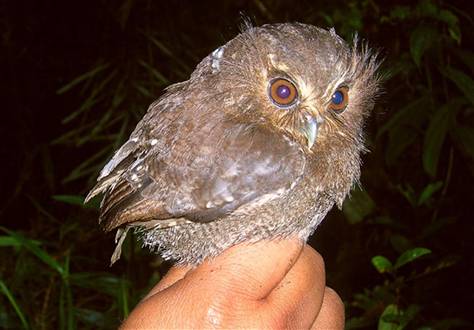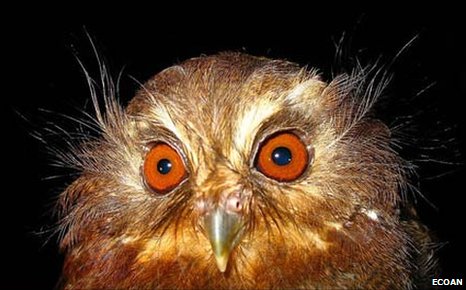
An extremely rare species of owl has been spotted by bird twitchers in Peru. The bizarre looking bird was first discovered in 1976 an remained out of sight since. The owl is so distinct that it has been named in its own genus, “Xenoglaux,” meaning “strange owl,” due to the long wispy feathers around its reddish-orange eyes. They have a round head with ear tufts and a yellowish bill. The bird looks very similar to a Western Screech-Owl, but has heavier barring on the breast, and is slightly smaller in size.
Insects, including caterpillars, are primary foods, but the diet incorporates a variety of arthropods, lizards, snakes, birds, bats, shrews, and mice. Moths as important prey are partly replaced by beetles, especially June bugs, during the climatic shift from warm, dry spring to cooler, wetter summer in Sierra Madrean habitats. Unless unduly disturbed, Whiskered Screech-Owls capture insects attracted to lights in suburbanized canyons and nest successfully along roads in campgrounds, next to houses, and in coffee fincas. They are unaggressive toward noninterfering avian associates and other animals, including humans, but warn of predators with Barks and defend offspring with dives and rare physical attacks.

Whiskered Screech-Owl is resident from the uplands of Central America north through the principal mountain regions of Mexico, except for northern portions of the Sierra Madre Oriental. Its range extends into the United States only in southeast Arizona and southwest New Mexico. In New Mexico, Whiskered Screech-Owls are known to be resident only in canyons of the Peloncillo Mountains, in south Hidalgo County. The species has also been recorded in the Animas Mountains; current status there is unknown.
Whiskered Screech-Owl is a Biodiversity Conservation Concern, Level 2 species for New Mexico, with a combined vulnerability score of 14. At the continental level, it receives high PIF vulnerability scores of 4 for its relatively small distributional range and population size. In the state of New Mexico, Whiskered Screech-Owl is listed as threatened by New Mexico Department of Game and Fish.
Fire is a potential threat to the species in the Peloncillo Mountains, through direct loss of nest cavities and alteration of dense woodlands, creating conditions more suitable for Western Screech-Owl (S. Williams, personal communication). Burning canyon bottoms and riparian areas in this region will be detrimental to Whiskered Screech-Owl, and other species, and should be prevented. Fire protection, resulting in considerable thickening of woodland and forest growth, has benefited Whiskered Screech-Owl, and the species will continue to abound wherever dense vegetation is allowed to remain on steep north-facing slopes and shady canyon bottoms (Marshall 1967).
Via: bbc
Tiny rare owl spotted in Peru reserve




